Critical flicker fusion test of potential vision
PURPOSE: To continue developing a potential vision test based on the critical flicker fusion (CFF) phenomenon by using a brighter stimulus and optimizing its size.
SETTING: Flinders Eye Centre, Flinders Medical Centre, Flinders University, Bedford Park, South Australia, Australia.
METHODS: In a prospective nonrandomized study, 225 participants were assigned to 1 of 4 groups: normal, media opacity only, retinal/neural disease only, and cataract plus retinal/neural disease. Participants were recruited if they were 20 years or older but were excluded if they had a neurological disorder or medication known to affect CFF. The CFF thresholds were measured for 3 stimulus sizes: 0.5 degree, 1.0 degree, and 1.5 degrees. Discrimination between groups was tested by analysis of variance and receiver operating characteristic analysis. The relationship between visual acuity and CFF in eyes without media opacity was determined by linear regression and used to predict visual outcomes in 23 eyes having cataract surgery.

Figure 1. The CFF testing apparatus.
RESULTS: The mean age of the 225 participants was 71.4 years ± 13.2 (SD); 134 (59.8%) were women. The normal group had 41 participants, and the other 3 groups had 61 participants each. Critical flicker fusion thresholds were reduced in retinal/neural disease but resistant to image degradation from media opacity. The 1.5-degree stimulus had 88% sensitivity and 90% specificity for discriminating groups. Visual acuity after cataract surgery was accurately predicted within ± 1 line in 43% of eyes, ± 2 lines in 83%, and ± 3 lines in 100%. All eyes with poor visual acuity (>0.50 logMAR) or dense cataract (> 4.0 Lens Opacities Classification System III) were predicted within ± 2 lines.
CONCLUSIONS: The CFF phenomenon effectively discriminated between subjects with and without retinal/neural disease and accurately predicted visual outcome after cataract surgery. The use of a brighter stimulus enhanced performance in cases of dense media opacity.
J Cataract Refract Surg 2007; 33:232-239
Accepted for publication October 24, 2006
Hema Shankar, BMBS, MA
Konrad Pesudovs, PhD
From the NH&MRC Centre for Clinical Eye Research, Department of Ophthalmology, Flinders Medical Centre, and Flinders University of South Australia, Bedford Park, Australia.
 CFF test of potential vision
as PDF (281 Kb)
CFF test of potential vision
as PDF (281 Kb)
![]()
Index of Papers
[ Welcome ][ Publications ]

